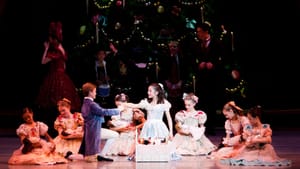Stay in the Loop
BSR publishes on a weekly schedule, with an email newsletter every Wednesday and Thursday morning. There’s no paywall, and subscribing is always free.
‘This is sort of a dream, right?’
How kids see ‘The Nutcracker’ (4th helping)

Precisely how do young children develop an appreciation for great art? That was the process I hoped to observe three years ago when my wife and I began taking our precocious granddaughter, Thelma Rubin-Rottenberg of Brooklyn, to the Pennsylvania Ballet's annual performance of The Nutcracker.
The story so far:
2010: Thelma, not quite three, was terrified by the human-size mouse sitting in the lobby before the performance. She was overwhelmed by the scale of the auditorium itself and reluctant to venture too close to the stage. But once the curtain rose, she was mesmerized by the combination of music and dance that unfolded before her. Her eyes didn't leave the stage for one second, and she provided a running commentary once she accustomed herself to the spectacle. (Click here.)
2011: Thelma was again fascinated and inquisitive about everything she saw on stage but troubled by the Mouse King's stabbing death— a concept yet unknown to her. By the final curtain, though, she had somehow come to terms with the dead rodent issue: "It's OK,” she assured us. "He's out in the lobby." (Click here.)
2012: Thelma, then almost five, was joined by her younger brother Roscoe, then almost three. This time Thelma demonstrated an increasingly sophisticated appreciation for the music, the dancing and the story. Of the overture, she remarked astutely, "It's like you get a taste of all the music." The Act II overture, she remarked, is "calming." Roscoe didn’t last past the intermission, but from his booster seat in Act I he patted the armrest in time to the music, kissed his own hand when the men on stage kissed the women's hands, and asked questions like, "How can I get up there (on stage)? Can I be in the ballet? Would I have to have special shoes?” (Click here.)
Good news and bad
This month the novelty was the presence of Thelma and Roscoe’s father. “I’m excited for Daddy,” explained Thelma (now almost six), “because he’s never seen The Nutcracker in his whole life.” To which Roscoe replied, “I’ve seen it, but I haven’t seen the second half.”
In this context Thelma assumed the role of an experienced connoisseur. From our Row H seats she observed, “The bad news about the front row is, you have to look up to see the dancers. But the good news is, you can see the orchestra really well.”
This time Thelma confidently anticipated the transparent opening curtains, the expanding and shrinking of the Christmas tree, the prospect that “Those toys we see will become real” and the appearance of the Philadelphia Boys Choir at the end of Act I (“Here come the people who sing ‘Ah-Ah-Ah’”). She astutely consigned the battle between the mice and the nutcracker men to the realm of dreams (“This is sort of a dream, right?... You see? It’s in her dreams. She’s dreaming.”)
Roscoe gets antsy
Roscoe (almost four), meanwhile, noted at the opening that “It’s going to start because the lights are going down.” During the overture he asked impatiently, “When will the curtain go up?” Watching the second act for the first time, he asked, “Why are there candy canes?” and noted that “It gets dark when the belly dancer comes, right?” When Roscoe got antsy and talkative toward the end of Act II (”I wish there was only one act”), his parents started to remove him, lest he disturb others sitting nearby, only to be reassured by a mother seated behind us: “This happens to everyone.”
At intermission I ran into the Philadelphia architect Alvin Holm, who seemed unencumbered by children. When I explained my purpose in introducing Thelma and Roscoe to the Nutcracker, he sighed. “I’m almost sorry I’ve seen it so many times,” he said, “because I can’t see it for the first time.”
What, When, Where
Pennsylvania Ballet: The Nutcracker. Choreography by George Balanchine; music by Tchaikovsky; Roy Kaiser, artistic director. Through December 29, 2013 at Academy of Music, Broad and Locust Sts. (215) 551-7000 or www.paballet.org.
Sign up for our newsletter
All of the week's new articles, all in one place. Sign up for the free weekly BSR newsletters, and don't miss a conversation.

 Dan Rottenberg
Dan Rottenberg